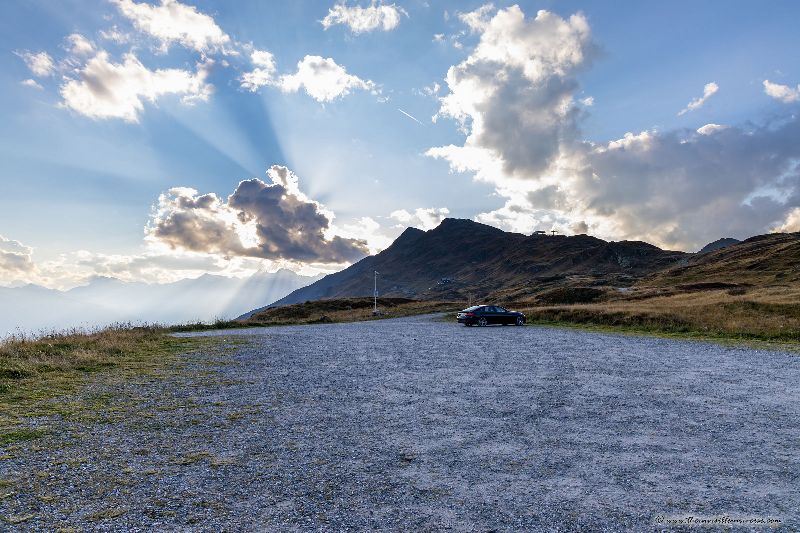- Top Links auf dieser Webpage:
Mein Youtube Kanal:
Astrophotography in the Alps - review of some observation locations
Please also visit my Deep Sky Gallery Main Page.
For a report about astrophotography at Col du Restefon in the French Alps please click here
During the Corona Summer of 2020, I was unable to travel to distant destinations because almost the entire world was in lockdown. So I explored the Alps in two excursions with my mobile astrophotography equipment and searched for suitable observing sites. The bright comet Neowise strengthened me in this decision, since it was not to be seen well from Germany due to the light pollution and the unsteady weather at that time. In the internet one finds scattered some recommendations for places in the Swiss and Austrian Alps, which are well suitable for astronomers. Therefore I drove off some points of which was to be read again and again. Among them are: the Gurnigel Pass, Grimsel Pass, Furka Pass and Susten Pass in the Swiss Alps, as well as the Grossglockner High Alpine Road with the Edelweiss Peak and the Silvretta High Alpine Road in the Austrian Alps.
On the following page I summarize some impressions and recommendations for these locations. It is clear that this is a very subjective impression of partly only short visits. If anyone has further recommendations, I'll be happy to include them!
As a further reading I could recommend the magazine Interstellarum Thema 1-2010 Astroreisen, which is free of charge available in the Internet as a pdf. Just google it!
Großglockner High Alpine Road, Austria
Großglockner Hochalpenstrasse, Edelweißspitze, Österreich.
The Grossglockner High Alpine Road with the 2572 m high Edelweißspitze northeast of the Grossglockner in the Hohe Tauern is probably one of the best known and best places for amateur astronomers in Europe. Absolutely dark skies and good transparency under suitable weather conditions are ideal prerequisites for astronomy. In addition, the Grossglockner high alpine road is well developed and there are some accommodation and supply possibilities. The best place on the road is certainly the Edelweißspitze itself. There is a large asphalt parking lot and a stone trum. From here you have a very good horizon view in almost all directions, even if you are surrounded by three thousand meter peaks.
This is the parking lot on the Edelweißspitze at sunset. During my stay the clouds disappeared one hour after sunset and we had a perfect clear night. The parking lot is usually empty after sunset, but very crowded with cars and motorcycles during the day. Leaving the telescope outside during the day is not an option. The nearby hotel is not an issue with regards to light. They switch off exterior lights after sunset and the rooms have blinds so that no light penetrates to the outside. Actually it is very convenient that you can go to the hotel after an observation night without the need to drive somewhere or sleep in the car. If the hotel at the Edelweißspitze is fully booked, there is also the hotel Wallackhaus about 10 minutes drive away. Despite a ban on night driving, it should not be a problem to drive to the hotel at night. Along the street of the Großglockner Hochalpenstrasse are further parking lots, were you might be able to set up a telescope at night. Those places are less busy compared to the Edelweißspitze, but the view of the night horizon will be limited by mountains.
After a long and clear night Venus and the moon appear in the southeast, together with the winter constellations Orion and Taurus. I was told that the road up to the Edelweißspitze is not cleared in winter and is only passable from about May to October. Night temperature may also drop far below zero during the winter and depending on wind conditions without a shelter staying outside could be a real challenge up there.
Besides the benefits for astronomy, the landscape itself is worth a trip to the Großglockner. The high alpine landscape and vegetation is very interesting and there are numerous opportunities for hiking. You might want to go to the official website of the Großglockner Hochalpenstrasse for more information. At 37.50 Euros, the daily toll for the Großglockner road is quite high. This should be included in the travel calculation if you plan to stay several days. Significantly cheaper is the Silvretta Hochalpenstrasse. It is unquestionably fascinating as a motorist to drive along this panoramic road, but there are more challenging roads in the Alps like the Silvretta. But it should be no problem to drive up there with a motor-home.
Image below: Looking to the south and to the Mittertörltunnel after sunset.
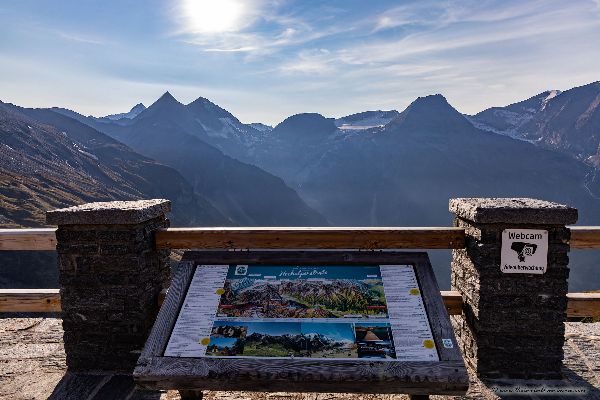 The alpine scenery of he Großglockner seen from the Fuscher Törl
The alpine scenery of he Großglockner seen from the Fuscher Törl 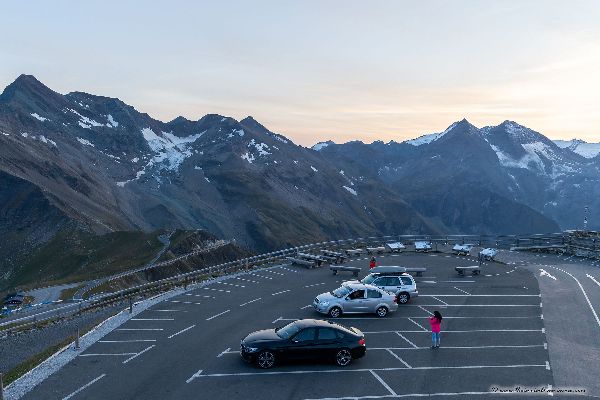 The parking lot on the Edelweißspitze
The parking lot on the Edelweißspitze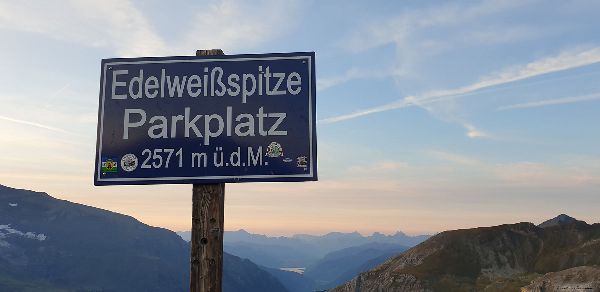
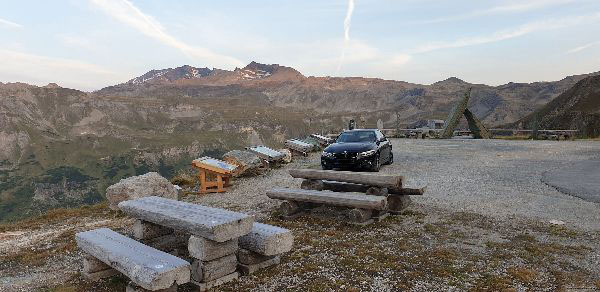 Another potential spot for setting up a telescope at night, a larger parking lot directly at the street.
Another potential spot for setting up a telescope at night, a larger parking lot directly at the street.
 The hotel at the Edelweißspitze
The hotel at the Edelweißspitze
Another panorama from the Edelweißspitze at sunset, made from the trum. Horizon visibility is very good in almost all directions. Only the trum itself obstructs a bit from the eastern horizon.
Verdict: if you want to have perfect night skies in central Europe, the Edelweißspitze is the place to go. Other places with even better night sky conditions are far more remote and hard to reach. For those who take a further drive, the Col du Restefond may be the better choice, as there the weather conditions are more stable in summer and you can admire the night sky even more secluded.
Silvretta High Alpine Road, Austria
Silvretta Hochalpenstrasse, Österreich.
The observation place at the Silvretta High Alpine Road is my persona favourite for two reasons: It is the easiest alpine pass road to reach from Germany with good visibility conditions, and you have enough infrastructure to spend a few days there.
The Silvretta observation spot is on a large long-term parking area close to the Bieler Höhe and the reservoir in an altitude of 2000m. High mountains are surrounding this area. You have a very limited view to the north and a mountains to the south limit the view as well. Many mobile homes are usually parking on this area during the night; disturbing light can not be excluded. Furthermore, the construction site at the Vermunt Werk at the reservoir has some very bright annoying lights at night, but if you are standing close to the northern boundary of the parking area, this will not be an issue for photographic and visual work. Two hotels are very close to the parking area and provide accommodation, food and rest-rooms. The observation spot at the Col du Restefond is definitely better. However, depending on where you are traveling from, the Silvretta region might be much easier to reach and has as already mentioned much better infrastructure. Two Hotels are directly at the Bieler Höhe. Restrooms are available and food supply is guaranteed.
Here you can the the long-term parking on a gravel square with a view to the South-West. There is lots of space to set-up equipment, but you should take care of lights from the mobile homes and other vehicles that might occur in the night. There is close to no protection against wind on this area.
Here is a comparison of the horizon at night between the Silvretta and the Col du Restefond in the French Alps. Please also visit my review of the Col du Restefond here. I have marked Messier 8 as a reference to indicate, how good the visibility of the souther horizon is at the observation spot at the Col de Restefond. However, on both locations the sky quality meter measured 21,7 mag sky brightness around midnight in early July. The Silvretta observation location on the long term parking area is maybe not the place with best visibility of the horizon, but still better than many other places in the Alps including the above mentioned location, except the Edelweißspitze.
An all-sky view of the nightsky at the Silvretta in September just before midnight. You can estimate the horizon visibility and the light pollution close to the horizon. The zenit is pitch black. Please compare this image with the all-sky view at the Col de Restond.
A gigantic snowplough takes care of clearing the road in winter, and in summer it stands impressively against the backdrop of the summer Milky Way at night. My small astrophoto equipment looks dwarfed by it.
The northern ascent to the Bieler Höhe is truly breathtaking! One of the most impressive roads I have seen and had the privilege to drive worldwide. The Silvretta High Alpine Road leads 22.3 km from Partenen in Montafon (1,051 m) in 34 hairpin bends over the Bielerhöhe at 2,032 m to Galtür (1,584 m) in the Paznaun Valley. The entire route is a toll road and a night parking ban applies on the entire Silvretta High Alpine Road, except the long-term parking. Unfortunately, this road is only open for public traffic from June to October. The rest of the year you can only reach the Bieler Höhe by public transportation.
The eastern ascent to the Bieler Höhe coming from Galtür and Ischgl leads through a V-shaped valley and lives up to the name panorama road.
 My imaging rig in July 2021 and the summer Milkyway
My imaging rig in July 2021 and the summer Milkyway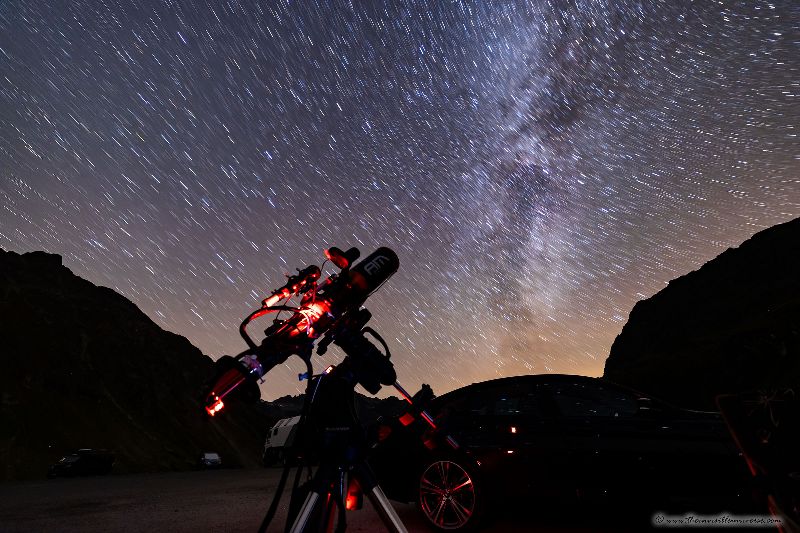 My astro equipment in September 2021 with the setting summer milky way on the western horizon.
My astro equipment in September 2021 with the setting summer milky way on the western horizon.
 Milkyway with my Imaging Rig and my trusty BMW.
Milkyway with my Imaging Rig and my trusty BMW.
 Two hotels are accommodating guest at the Bieler Höhe, if there is no lockdown...
Two hotels are accommodating guest at the Bieler Höhe, if there is no lockdown...
 The northern ascent of the panorama street
The northern ascent of the panorama street
 The Silvretta Reservoir
The Silvretta Reservoir
 The Bieler Hoehe seen from a trekking path in the mountains
The Bieler Hoehe seen from a trekking path in the mountains
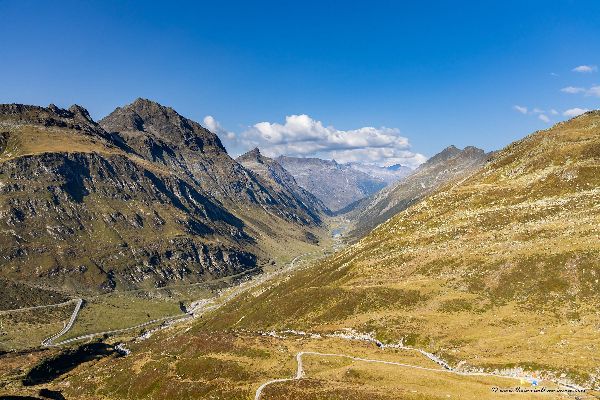 Amazing view down to the Silvretta Road
Amazing view down to the Silvretta Road

Picture above: A small church is located at the Bieler Höhe. Below: The same church at night, seen from the long-term parking area. During my visit in September 2021, the constellation of Orion was ascending in the second half of the night. Canon EOS R with RF 24-105 at 85 mm f4 and ISO800.
I would like to mention the Kaunertal Glacier Road as well, which is close to the Silvretta Passroad, about 1.5h drive away. In contrast to most of the alpine pass roads, this road is not closed during the winter, as there is a skiing area at the end of this windy and long road. However, I did not find a single spot, were I would set up a telescope. High mountains, narrow streets, and the illuminated skiing area are in my opinion a no-go for astronomy.
Gurnigel Pass in the Swiss Alps
Der Gurnigelpass in den Schweizer Alpen.
The Gurnigelpasshöhe with 1608 m in the Swiss canton of Bern, only a few kilometres as the crow flies from the 1000m lower situated town of Thun, is a popular destination for Swiss amateur astronomers because it can be reached quickly. A large asphalted parking lot, formerly a tank shooting range, on top of the pass and the Gurnigel Berghaus with a hotel and restaurant offer sufficient infrastructure to spend a few days here. However, there is a fee for the parking lot.
During my visit in July 2020 to observe the comet Neowise I had to notice some disadvantages of this location. The sky is relatively bright due to the proximity to larger cities in the east and north like Thun and also Bern. In addition, the view to the north (Neowise was deep in the north) is very limited, so that I had to look for an alternative place with good north view. To the south, a mountain range obscures the low southern horizon somewhat.
In addition, the parking lot is extremely frequented, especially by motorcyclists and the car tuner scene. From quiet retreat can not be the speech here. During the day, one had the feeling that pretty much every Swiss who owns a motorcycle, with excessive speed and sawed-off exhaust thunders up the pass.
Despite this, the popular Swiss Start Party telescope meeting takes place here regularly in September.
My personal conclusion: for amateur astronomers living in the region, the Gurnigel Pass will certainly be a good quickly accessible location. If you are traveling from further away, this location is only a good choice if the weather conditions are better than elsewhere.
The parking lot at the Gurnigel Pass. Lots of space, but unfortunately very popular with motorcyclists and other petrol heads who use the asphalt as a race track. The view to the north is obstructed by the Selibüel mountain. In the Southeast is the city of Thun with its lights disturbs the view.
In July 2020 I visited the Gurnigel Pass and Gantrisch to watch Comet Neowise. From a small parking bay on a lonely street up the hill I had a perfect view to the north and the comet. But as you can see, the valley of the Naturpark Gantrisch is quite bright, not only due to the summer solstice, but also due to the lights of many smaller towns and Bern itself.
If you visit the Gurnigel Region, you should do a walk up to the Selibüel mountain (1750 m). From there you have a wonderful view down to the valley and the city of Thun of the Berner Oberland.
 One of the rooms in the Berggasthaus Gurnigel. This is actually a room for a Swiss Officer.
One of the rooms in the Berggasthaus Gurnigel. This is actually a room for a Swiss Officer. The Berggasthaus Gurnigel is very popular among bikers.
The Berggasthaus Gurnigel is very popular among bikers. Some kilometres further down the road I found a nice spot in Gantrisch to watch Comet Neowise in the North.
Some kilometres further down the road I found a nice spot in Gantrisch to watch Comet Neowise in the North.
Grimsel and Furka Pass in the Swiss Alps
Der Grimselpass and the Furkapass in den Schweizer Alpen.
The Grimselpass and the Furkapass in the Berner Oberland appear in astroforums again and again as astronomical observation sites. Therefore I had decided in summer 2020 to drive down these two passes after my stay at the Gurnigelpass to photograph comet Neowise. The drive from the north up to the Grimsel Pass, passing the three reservoirs Räterichsbodensee, Grimselsee and Oberaarsee can certainly be classified as absolutely spectacular. The view from the - unfortunately very busy - road down to the reservoirs and the magnificent alpine scenery is worth every drive. Up on the 2164m high Grimselpasshöhe with the Totensee, however, is also correspondingly busy. Numerous cars, campers, and far too many motorcycles drive along here or park in the large parking lot at the Hotel Restaurant Alpenrösli. If you want to go one better, you can drive the panoramic road Oberaar, which starts at this very parking lot and is subject to toll. During the day, this region is really great. But all the hustle and bustle doesn't create the mood to set up your telescope here at night and observe. Possibly there are still hidden places here, which I do not know and at which one can observe well but. But I had decided for me to go on and not to stay here.
This is the Grimselsee and the Grimsel Hospiz on the small island in the centre. The the driveway is magnificent!
The parking lot at the Grimsel Pass and the Hotel Restaurant Alpenrösli. There are many brave cyclists who have managed to climb the steep pass.
If you continue south from the Grimsel Pass, after a steep descent into the canton of Wallis, you will come to an even steeper road up to the Furka Pass. This ascent is also magnificent. Passing the Rhone glacier, you then reach the Furka Pass at 2429 meters, a slightly higher altitude. This is marked by a large gravel parking lot, which is also much frequented. Unfortunately this point is topographically like a wind tunnel and at least during my visit there was an unpleasant strong wind - unsuitable for astrophotography.
Top picture: the Rhone Glacier and the Glacier lake at the Furka Pass, seen from the Grimsel Pass Road. The Furka Pass Road winds up and vanishes behind the mountain to the left. This part of the swiss Alps has probably one of the most amazing views!
Picture below: The parking lot at the Furka Pass Road is not very inviting.
Only later I read that there is a much better place at the Furka Pass. Driving in the direction of Realp, one turns left at the Tiefenbach Hotel in the direction of the Alber-Heim-Hütte and the Tiefenbach Parking Place and drives about 3km to a tank shooting range of the Swiss army in an altitude of about 2300m. In Oktober 2021, during a non-astro vacation in the swiss Alps, I managed to visit this area again and drove up to this spot during the daytime. Weather was not good during my visit, so astronomy was not an option. But this place should be ideal for setting up a telecope at night! The next bigger town is Andermatt a 30 min drive away, with Hotels and supermarkets (I can recommend the fantastic Raddison Blu Hotel in Andermatt!).
The observation site has several smaller gravelled stands with very good horizon views to the south. The ascent via a small gravelled steep driveway is no problem with a car. There are no passage restrictions in summer. However, the Furka road is closed in winter between the end of October and about May because of snow. Therefore, this place is only accessible in the summer months.
Apart from Andermatt, there are no larger settlements. Therefore, the sky there should also be very dark.
Because of the remoteness, amateur astronomers have their peace and quiet there. However, there is no infrastructure such as electricity, water or toilets. You should keep that in mind.
Unfortunately, I have no information about the local weather situation and the number of clear nights there. In the mountains, clouds may persist on the mountain tops and limit visibility.
I will try this place out as soon as I have another opportunity.
Images below: the Astro location in October 2021.
 The driveway to the Astro location.
The driveway to the Astro location.
 The famous James Bond Road where 007 observes Goldfinger.
The famous James Bond Road where 007 observes Goldfinger.
 Driveway to the Alber-Heim-Hütte and the Tank Shooting Place at the Furka Road
Driveway to the Alber-Heim-Hütte and the Tank Shooting Place at the Furka Road
 Driveway to the tank shooting place and the Astro location.
Driveway to the tank shooting place and the Astro location.
 Panorama of the tank shooting place and the Astro observing loaction at Furka pass.
Panorama of the tank shooting place and the Astro observing loaction at Furka pass.
Otherwise there is still the Nufenenpass very close to the Furkapass, from which from astronomical point of view is to be heard again and again. Unfortunately, I had not been there myself and can therefore not give a first-hand report.
Susten Pass in the Swiss Alps
Sustenpass in den Schweizer Alpen.
The Sustenpass at the border between the Kanton of Bern and Uri is another possibility to do astronomy under high alpine skies. The pass is 2224 m high and a popular tourist route. From the west, after a tunnel, one arrives at the Sustenpass summit. There is a parking lot, the Sustenpass lake and a small hotel Berggasthaus Sustenpass with a restaurant. Further down the road there is another Hotel Berghotel Steingletscher. During my visit in the summer of 2020, there was a construction site there because of a tunnel renovation and the parking lot was not accessible.
I spent the night at a small parking bay in front of the tunnel directly at the road. At night there was almost no traffic, but early in the morning the noise of numerous motorcyclists made me awake and the short rest after a long night of observation was over.
There is a parking lot at the end of a gravel road coming from the Alpine centre Sustenpass, that could be a nice remote location at night, but horizon visibility should be not better than at the Sustenpass itself. If someone has another recommendation for a good location at the Sustenpass, I am happy to hear from you!
I must say that I was somewhat disappointed by the Swiss alpine passes I visited: High mountains limiting the view, too much traffic and hustle and bustle, or too much light pollution for a high alpine region. If you live in or around Switzerland, this may be an option. For astronomers who have to travel a long way, the trip to the Swiss Alps is only worthwhile if the weather outlook is better than at otherwise more suitable locations for astronomy, such as the Grossglockner. Maybe I just have not found the ideal location for astronomy in the Swiss Alps yet!
The Sustenpass Lake after sunset.
The pass road down to the west after sunset.
Horizon panorama of the milky way at night, made from a small parking bay at the Sustenpass road near the tunnel. There is a traffic light at the tunnel, as there was a construction site in 2020.
Jaufen Pass in the Italian Alps
Jaufenpass in den Italienischen Alpen.
The Jaufen Pass near the town of St. Leonhard in the italian Alps connects the Passeier Valley with the Brenner Pass. As an alternative to the Timmelsjoch, which is well worth seeing, and which leads over the border to Austria into the Ötztal, the Jaufenpass is not as busy. The easily passable mountain road climbs 2100 m. The Jaufenpass as an astro-observation site is mentioned again and again in the astroforums. When I was on my round trip from the Silvrettapass over the Stilfser Joch and the Timmelsjoch to Sölden in September 2021, I took the opportunity to drive up the Jaufenpass late one afternoon. The only observation site for amateur astronomical purposes I found there is the car park at the Römerkehre, about 2 km from the pass and directly below the Enzianhütte mountain inn.
A short but very steep 200m long driveway leads from the pass road up to this gravel site with a good south west view into the Passeier valley. Hikers park there during the day. At night the place should be lonely and deserted. The panoramic view is relatively good, but the light pollution from the valley may be disturbing. Due to the weather, I didn't stay up there all night, but spent the night in St. Leonhard and drove back to the Silvretta Pass via Sölden. The Enzianhütte could have served as an alternative accommodation at the top of the pass. But a tour of the rather rudimentarily equipped rooms without en-suite bathrooms and the comparatively high price put me off. If you are coming from the Italian region, the Jaufen Pass may be a good alternative to the Silvretta Pass or the Edelweiss Peak for observation. Coming from the north, however, the journey is too long and there are better alternatives on the way.
Panorama of the parking spot at the Römerkehre near the Jaufenpass just before sunset.
Lots of empty space for setting up a telescope. The view to the south is great, but the towns in the Passeier valley like Sant Leonhard might disturb the nightsky with some light pollution.
View to the south.
The driveway to the parking spot.


















 The large parking lot the the Gurnigel Pass.
The large parking lot the the Gurnigel Pass. Panorama of Selibüel.
Panorama of Selibüel.

















